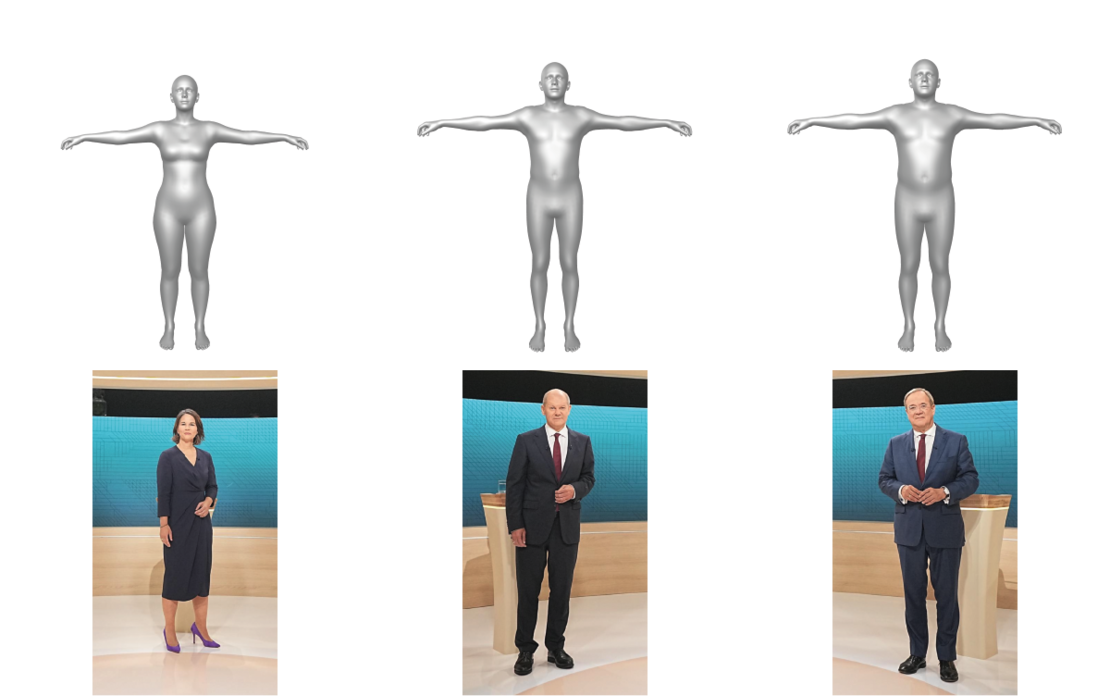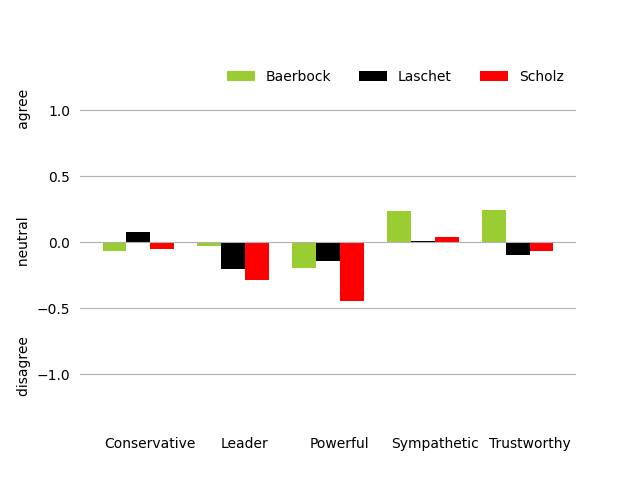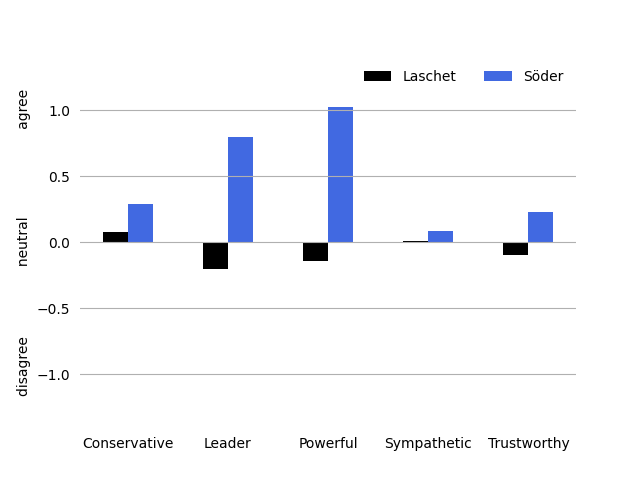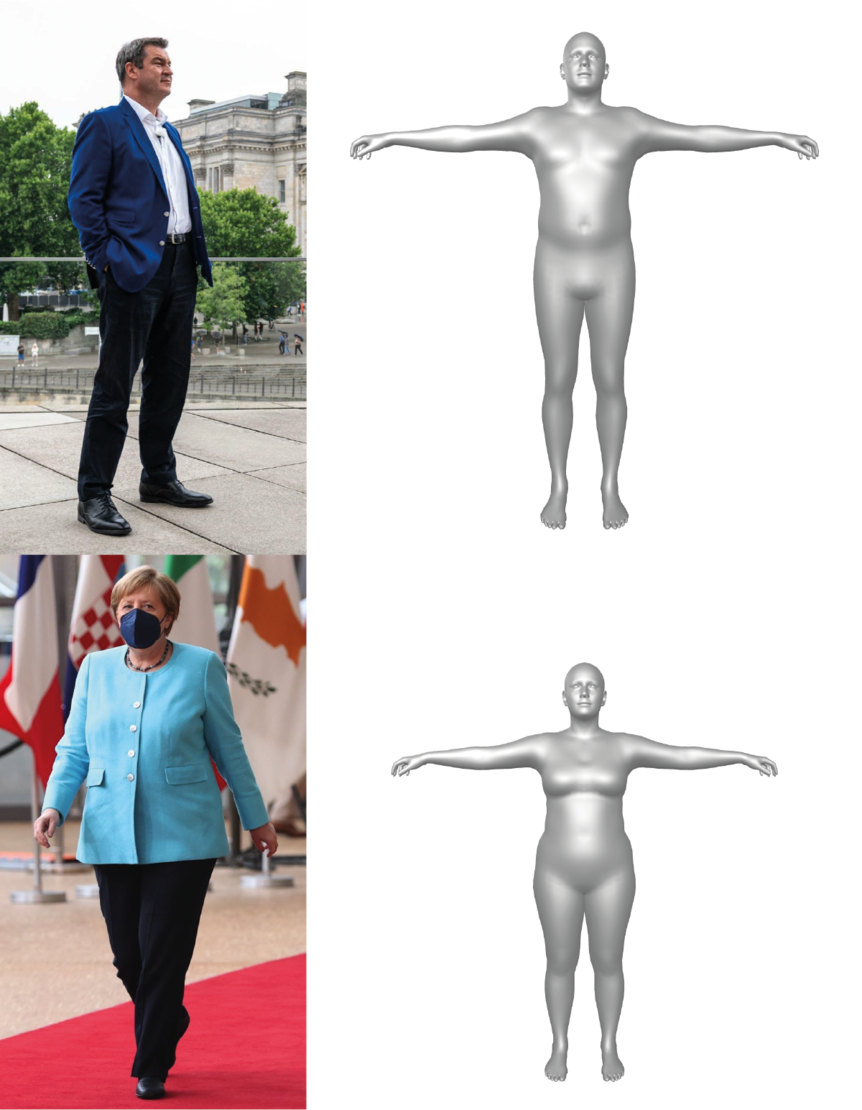Could body shape determine the German election?
Our perception of leadership traits is influenced by body shape
05 September 2021 Michael J. Black, Lea Müller 5 minute read
Could biases in how we perceive body shapes influence the outcome of the German election? Using recent work from our group, we investigate which of the chancellor candidates is perceived to be a good leader, solely based on their body shape.

By Lea Müller, Alejandra Quiros-Ramirez, Stephan Streuber, and Michael Black
The German elections are tomorrow and, with Angela Merkel stepping down after 16 years, change is coming. One hopes that voters make well-informed choices based on their political beliefs. But could they be subconsciously influenced by other factors such as the three-dimensional (3D) body shape of the candidates?
Recent work from our group [1] has shown that people make judgements about others, in the absence of other information, based on their body shape. Particularly striking is that these judgements correspond to leadership traits that are central to electoral decision making. In particular, US voters find certain body shapes to be more trustworthy, more leader-like, more compassionate, or more conservative.
Of course, this doesn't mean that a particular body shape makes a person more conservative. What the analysis reveals is that we may hold subconscious biases about people based on nothing more than the shape of their body. Could such biases influence the outcome of the German election?
To answer this question, we analyzed the 3D body shapes of the top candidates, Chancellor Merkel, as well as Marcus Söder, who was a possible chancellor candidate but who was not selected by his party for the leadership role. Ideally, we would have captured 3D body scans of the candidates but this wasn't possible. So, we took images of them from the internet and showed these to subjects who rated their body shape according to various words related to body shape. From this, we are able to reconstruct the 3D shape of their bodies. See the paper on BodyTalk for details of how we recreate 3D bodies from descriptions [2].

The 3D body shapes estimated from these ratings roughly reflect the body shapes of the candidates.
To relate these shapes to perceived political traits, we use the pre-trained mathematical model defined in [1]. This was trained with US voters who viewed 3D body shapes and rated them for various traits including many political traits. Note that these US voters never saw images or body shapes of the German candidates. Also note that US and German voters may have very different political biases, so take our conclusions with the appropriate grain of salt.
Given the 3D body shapes of the candidates we predict how voters judge several relevant traits, in particular conservative, leader, powerful, sympathetic and trustworthy. We summarize the results in the following figures (raw data below).
The differences between candidates are relatively small but some interesting observations can be made. First Laschet, the conservative candidate, is rated as more conservative purely based on 3D body shape. Neither Laschet or Scholz are strongly perceived as a leader and here, Baerbock is ahead. Baerbock and Laschet are seen as more powerful, according to the body shape bias. Baerbock, in particular, is perceived more sympathetic and trustworthy.

Note that we also captured ratings for Söder, who is not a candidate for chancellor. His competitor, Laschet, was chosen to run instead. Based on body shape bias, one sees that Söder is particularly perceived as more powerful and a better leader.

Finally, we compare Angela Merkel's ratings with those of Baerbock, Laschet and Scholz. Her ratings, based on body shape bias, are similar to those of Laschet (leader, powerful) and Baerbock (powerful, sympathetic).

It remains questionable to what extent the US bias can be transferred to German voters and how much influence such biases ultimately have on election decisions. Clearly, it would be unwise to choose leaders based on their body shape but it is worth understanding the subconscious biases that people may hold so that potential leaders can address these biases with their actions. Our subconscious body shape biases are not only political, so is important to be aware that they exist and that they may influence our decisions and attitudes towards others.
Can we predict a winner? No. We will all have to wait and see.
References:
[1] Quiros-Ramirez, M. A., Streuber, S., Black, M. J., "Red shape, blue shape: Political ideology influences the social perception of body shape," Humanities and Social Sciences Communications, 8(148), June 2021.
[2] Streuber, S., Quiros-Ramirez, M. A., Hill, M. Q., Hahn, C. A., Zuffi, S., O’Toole, A., Black, M. J., "Body Talk: Crowdshaping Realistic 3D Avatars with Words," ACM Trans. Graph. (Proc. SIGGRAPH), 35(4):54:1-54:14, July 2016
The raw data is as follows:
A value of 3 means a neutral rating, values below 3 disagreement and values above 3 agreement. To visualize these numbers in the plots above, we subtract x - 3.
'Conservative' Merkel 2.998339015342321 Baerbock 2.931548755871181 Scholz 2.951734251131159 Laschet 3.0819921177612235 Soeder 3.289106933882037 'Leader' Merkel 2.778194991863105 Baerbock 2.974469823964682 Scholz 2.7188160323623127 Laschet 2.7949244738202106 Soeder 3.797813336203826 'Powerful' Merkel 2.82948729550923 Baerbock 2.804714364603354 Scholz 2.553359918915314 Laschet 2.8595327799087626 Soeder 4.025671596584516 'Sympathetic' Merkel 3.225481256370155 Baerbock 3.237000657013683 Scholz 3.0381233530790626 Laschet 3.011947929182152 Soeder 3.083235416458945 'Trustworthy' Merkel 3.13258934188543 Baerbock 3.2492321091633127 Sholz 2.933605836570454 Laschet 2.9073793388904594 Soeder 3.2275310806218487
Reconstructions of Söder and Merkel:

The Perceiving Systems Department is a leading Computer Vision group in Germany.
We are part of the Max Planck Institute for Intelligent Systems in Tübingen — the heart of Cyber Valley.
We use Machine Learning to train computers to recover human behavior in fine detail, including face and hand movement. We also recover the 3D structure of the world, its motion, and the objects in it to understand how humans interact with 3D scenes.
By capturing human motion, and modeling behavior, we contibute realistic avatars to Computer Graphics.
To have an impact beyond academia we develop applications in medicine and psychology, spin off companies, and license technology. We make most of our code and data available to the research community.
